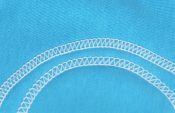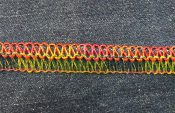Discover the coverstitch machine bernette 42 FUNLOCK. It gives an extra possibility to neatly finish hems in stretch or woven fabric and there are many more features. What’s the difference with an overlock? First, let’s find out what a cover stitch machine does.
I heard that someone sold this machine for health reasons. The price was reasonable and I did not doubt.
Visit the bernette site for more information:
The low-cost 4-thread and 3 needle coverstitch machine – for professional hems
The bernette 42 FUNLOCK is a coverstitch machine featuring a total of 3 different coverstitches with a width of 2.8 and 5.6 mm and a chain stitch. With it, you can provide your hems, edges and cuffs with professional stitches, giving your sewing project the perfect look. Excellent results can be achieved with the bernette 42 FUNLOCK, even with very stretchy fabrics and thin knitted fabrics. Threading the needles and loopers is also really easy, thanks to the separate needle threader and the looper threading mechanism. And to give you a good view of your sewing project, the bernette 42 FUNLOCK also has a bright LED light.
The bernette 42 is a no-fuss machine. Still it has very interesting settings for differential feed, stitch length and pressure.
The difference between an overlock and a coverstitch machine:
An overlock finishes fabrics and seams by cutting an edge and making stitches over that edge. The overlock machine does not sew in the middle of fabric. It has loopers that go over the edges. An overlock machine can be used to sew seams and finish at the same time when using a 4-thread stitch in knit fabric (like T-shirts or sweaters). In that case you don’t use the standard sewing machine for the seams.
A coverstitch machine (or coverlock) can sew in the middle of a fabric. It can thus sew a few cm from the edge, to sew a hem. In the illustration beneath you can see how the back side of the sewing line looks. When sewn upside down, you can use it for a beautiful decorative stitch. And think of variegated thread…
The cover stitch:
You can see that a cover stitch machine makes a different stitch from a standard sewing machine. On the top side you have a stitch that looks like the standard sewing stitch, but the cover stitch is on the bottom side. This stitch adds stretch to the stitch, because it contains the little loops and extra thread length on the back. It’s ideal for stretch fabrics. To add extra elasticity to the seam, flock thread is used.
Most cover stitch machines can sew up to 3 lines besides one another, so you can use 3 needles at the same time. Make a narrow or a wide 2-needle stitch line by taking away a needle.
A one needle stitch line is also used in confection for garments.
These are the stitches for the bernette 42:
Applications for the coverstitch machine:
The cover stitch is best known to use in hems for knit fabric, like T-shirts or sweaters. When using some extra presser feet, the bernette 42 is capable of many more applications than hemming.
There’s also a decorative look, when you sew the cover stitch on the right side of the fabric. You can even use decorative threads for an extra effect. Sew on lace or ribbons, or even sew belt loops.
So, you see a cover stitch machine is basic for hemming, but in some next blogposts you will find out it can do a lot more than hemming. This machine does not replace your standard sewing machine. It does not make button holes or sew zippers.
It was my idea to help you discover the coverstitch machine bernette 42 FUNLOCK. In some other blogposts I will show you how to thread, start and finish a seam and what else you can do with this beautiful machine.
 BERNINA Corporate Blog -
BERNINA Corporate Blog -








0 Responses